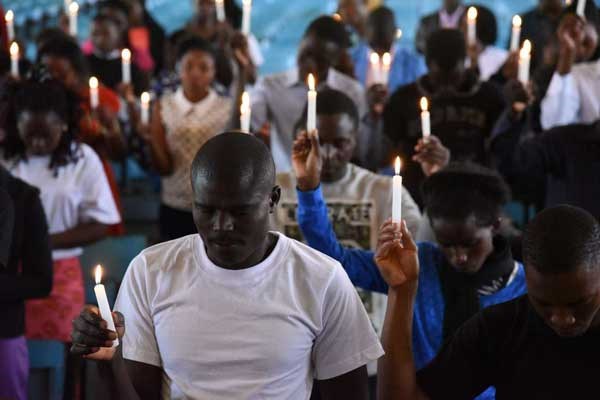
Wednesday April 11, 2018
By STELLA CHERONO

Moi University students during the memorial service for 148 Garissa University College victims. The April 2 service was at the main campus, Eldoret. PHOTO | JARED NYATAYA | NATION
Details of a terrorist attack foiled by police last month show that al-Shabaab local operatives are increasingly posing a grave danger to Kenya.
The plot by homegrown elements of the Somalia-based terrorist group targeted the Judiciary.
Detectives are still processing the seized vehicles, which suicide bombers reportedly planned to use in the raid.
Those familiar with the sophisticated plot say it shows the changing face of terrorism.
The classic picture of AK47-wielding men with bushy beards behind a black flag is no longer the major focus in the war against violent extremism.
Mr Tyrus Kamau Muya, a security consultant, says terrorism has evolved in recruitment, membership and tactics.
TERRORIST
“It is not easy to single out a recruit or recruiter. It is even more difficult because the stereotype of your typical terrorist has moved from an individual of Arabic or Somali extraction to just about anyone,” Mr Kamau said.
Terrorist groups are now made up of university students, young, charismatic and eloquent youths who have been brainwashed and ready to kill.
The situation is complicated by the widespread availability and accessibility of social media.
Counter terrorism support group, Epuka Ugaidi says: “With the changing face of terrorism, the enemy could be anyone.”
Mr Muya says recruiters turn to unsuspecting groups and never expose themselves from the onset.
CHAIN OF COMMAND
“This is of course precautionary and as a result, they will use fellow students to get recruits. The chain of command is very long and convoluted,” he said.
He adds that in recent times, technology has made recruitment even easier.
With apps such as Signal and Telegram, which guarantee almost complete anonymity, people are often approached by their peers then added to the group chat apps for more indoctrination and conversion.
Al-Shabaab has recruited beyond its boundaries using the internet which demands few resources, little effort and time.
The gangs also fight their battles on social media, where they easily evaluate their success by the number of likes, shares, views and comments.
WESTGATE ATTACK
An example is the October 2013 Westgate attack in Nairobi that left at least 67 people dead and more than 100 injured.
A Twitter handle HSMpress, suspected to belong to al-Shabaab continuously updated the world on the happenings in the mall as it taunted Kenyan security forces.
The United Nations Security Council expressed concerns in February that under the new conditions, terrorist organisations are expanding and strengthening the network of cells, most of which operate with a certain degree of autonomy, making it difficult for governments to detect them.
A number of Kenyans have been used by terrorists to carry out attacks on their own people.
Ahmed Iman Ali was reportedly involved in many operations at the Coast while Abdirahman Mohamed Abdullahi led the group that attacked Garissa University College in April 2015, killing 148 people, mostly students.
CHANGED TACTICS
“Terrorist groups know that government agencies closely monitor them and so they have shifted their tactics,” Mr Muya said.
Apart from recruitment, the terrorists are increasingly targeting women for tasks which require a bit of social engineering like access to buildings.
Women have also been used as fighters and recruiters.
In September 2016, three women armed with grenades and knives were killed in Mombasa when attacking a police station.
More women are ready to join terrorist groups and even travel outside the country to join them.
Records show that at least 100 Kenyan women have joined al-shabaab and the Islamic State group. At least 20 have been killed in the last three years.
National Police Service director of communications Charles Owino says terrorists are also using children as young as six to carry our raids.
EXPLOSIVES
“Children can be used to plant explosives on roads because few people suspect them,” Mr Owino said.
The use of vehicle bound improvised explosive devices, similar to the ones seized in Merti, Isiolo County in March, is another new but increasingly common tactic used by terrorists.
The emergence of the lone-wolf attack tactic complicates intelligence gathering. A lone-wolf operative usually attacks with a gun, machete or even a vehicle with the intention of killing as many people as possible before being arrested or killed.
Such a method was used at Deputy President William Ruto’s home in Sugoi and by a man who attempted to stab a General Service Unit officer outside the US embassy in Gigiri.
LONE ATTACKERS
Experts say lone attackers are unpredictable and difficult to stop.
The metamorphosis of terrorism calls for extreme vigilance, especially by the public because recruiters, recruits and attackers live closer to them.
“Some tell-tale signs which can help identify potential recruits include instantaneous wealth, an abrupt shift in schedule and sporadic unexplained journeys for days or weeks with no alibi,” Mr Muya says.
Anti-Terrorism Police Unit boss Munga Nyale believes the multi-agency approach has and will help security agencies in the fight against anarchism.
The police, military and the National Intelligence Service are on the frontline in the war on terror.